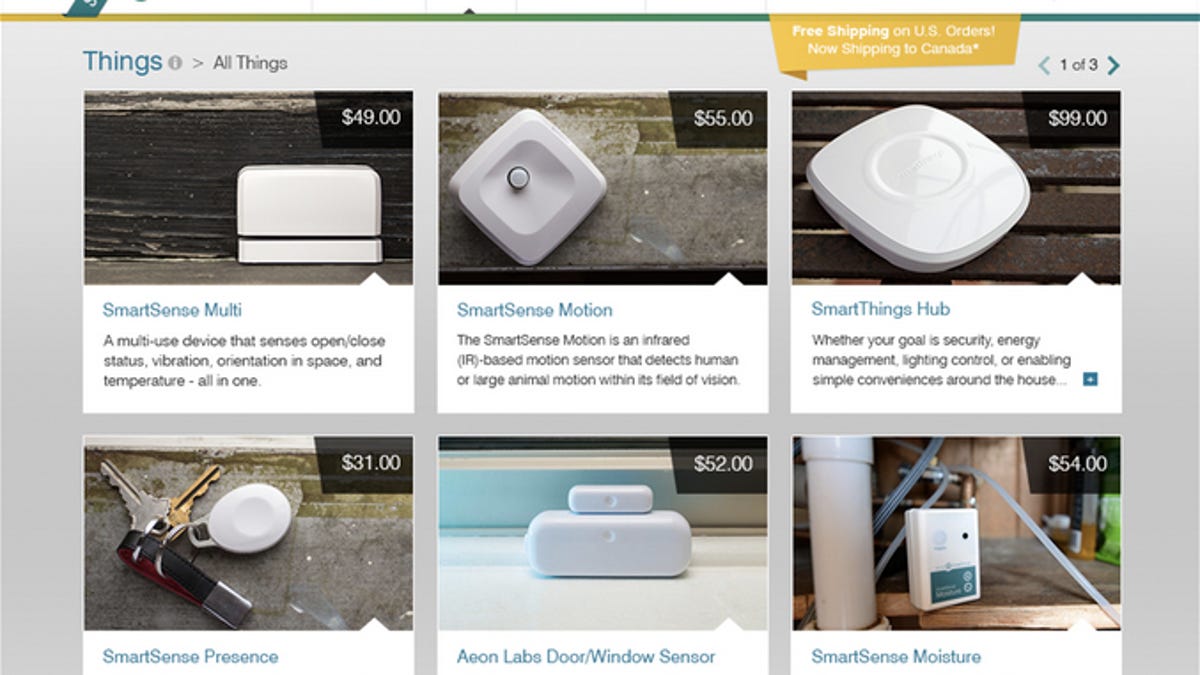SmartThings opens shop for Internet of Things
CEO Alex Hawkinson hopes to build a giant "physical graph," an analog to the social graph, for the Internet of Things.

The Internet of Things is open for business, and SmartThings wants to be the hub that connects developers and device makers with consumers. The startup launched the SmartThings Shop, a marketplace for hardware and apps that do everything from unlocking doors and turning lights on or off to keeping valuables safe and triggering a siren sound when a dog jumps on the couch configured with an embedded sensor.
SmartThings is building what CEO Alex Hawkinson calls a "physical graph," an analog to the social graph for the Internet of Things. Hawkinson's notion of a physical graph comes to life in SmartThings' cloud, which is the hub that connects and adds intelligence to potentially billions of connected objects.
Unlike Nest (thermostats), Dropcam (Wi-Fi cameras) or Fitbit (health and fitness tracker), SmartThings is an open-source platform that primarily depends on a developer community to build momentum and a real business. The startup has more than 3,000 developers supporting its platform so far, the company said.
SmartThings' Selling Proposition
SmartThings is selling its hardware at close to cost, Hawkinson said, but plans to make money by taking a slice of revenues from its app developer community. In addition, the company is looking to take a fee cut from service providers associated with the SmartThings network. For example, if a SmartThings sensor detects a home security problem, the app could immediately dispatch a local security service. If moisture sensors detect a problem, SmartThings could guarantee that a plumber will show up within a certain period of time.
Appliances are also becoming part of the Internet of Things. It may not be practical to load up a toaster with sensors that can tweet out when your bagel is done, but it would be useful for washers, dryers, ovens and other hefty appliances to offer status updates as well as safety alerts.
Dryers and washing machines were involved in one out of every 22 home structure fires reported to U.S. fire departments between 2006 and 2010, according to the National Fire Protection Association. Clothes dryers were the main cause of 92 percent of those fires, totaling more than 15,000 in 2010.
"Appliances have a slow-moving replacement cycle," Hawkinson said. "We are talking to big names about the roadmap, and we don't have to do anything special because of the standards. It would take $20 to retrofit existing appliances to know the temperature of a dryer."
If successful, SmartThings will collect and aggregate a lot of useful, anonymized data in its cloud. Insurance companies, for example, could analyze SmartThings usage patterns that could be applied to their risk assessment and pricing algorithms.
Internet of Things Ready for Take-off
SmartThings, which has 44 employees, raised $1.2 million in a Kickstarter campaign to build a community and get feedback about the product, and more than $4 million from founder and angel investors.
Hawkinson thinks the timing it right for the Internet of Things to take off.
"As the smartphone becomes the center of communication, media and banking, it's ready to be useful in rest of your life" said Hawkinson. In addition to smartphones and apps as remote control devices, he said that the Internet of Things is being driven by the availability of low-power, high-range mesh networks (such as Bluetooth Zigbee and Z-wave); cloud computing; cheaper hardware enabled by 3D printing and lower cost chips and sensors; and the cost dropping to less than $5 to connect things.
"With the democratization of hardware, with robotics and 3D printing, you don't need a factory," Hawkinson said. "You need some electronic engineering expertise and a few thousand dollars."
SmartThings is not alone in building a business around the emerging Internet of Things. Giants such as Comcast are making a major push with subscription-based home security and automation services, and startups such as Revolv and Ninja Blocks are developing no-contract, open platforms.
SmartThings Shop
With the SmartThings Shop, for mobile web and desktop, Hawkinson is following the model of Apple's App Store, curating the content and crafting a review process for third-party products and services.
SmartThings Shop is currently offering two starter kits for home control applications, for $199 and $299. The kits include the SmartThings hub and various sensors and devices for receiving notifications when people, pets, and cars arrive and leave, turning on lights or a TV in response to motion detection and other home control scenarios. The shop also has individual items, including SmartThings-compatible devices from GE, Schlage and Kwikset, and solution sets for various categories, such as keeping track of kids and elders, turning off appliances via a phone and controlling and automating lighting.
Securing the Internet of Things
In connecting more things to the Internet, cyber-criminals have exponentially more points of access to invade sensor-based devices and apps. "At the DNA level we are super-mindful of privacy and security," Hawkinson said. He isn't recommending that defibrillators be integrated with SmartThings, but "SmartApps" can only access devices that are explicitly configured by users.
"Each device across the entire network has a globally unique ID at the hardware level that cannot be spoofed, and hardware level encryption with new keys regularly established between the SmartThings Hub and the SmartThings Cloud," he said.
The reality is that a burglar is more apt to break a window to gain access to a home than hack an encrypted lock. "In all cases, it would be much better for the homeowner to have connectivity and awareness of events taking place versus not," Hawkinson said. That sounds like the beginnings of a good business plan.

